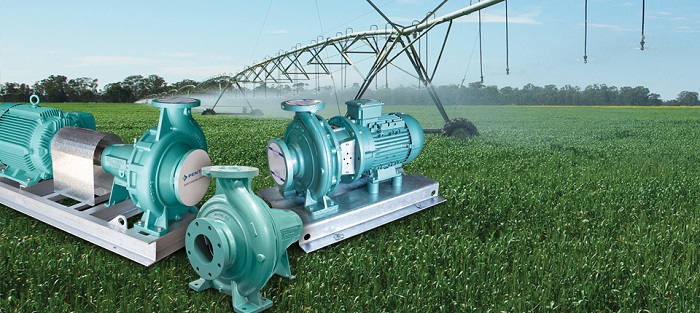rrigation pumps are usually used to pump water from a lower to a higher level from which the water then flows through channels to the fields requiring irrigation or to raise it to the required pressure head in order to spray the fields via piping systems (sprinkling). The heads involved range from approx. 1 m for normal lift operation to 40 m for sprinkling. Ocassionally, heads more than 100 m may be required.
At times, irrigation pumps are usually not equipped with variable speed drives. The flow rate can therefore be controlled by either switching the pumps on and off, or by using a throttling valve in the discharge pipe, pre-swirl control (e. g. cooling water pumps), rotational speed or impeller blade pitch adjustment. Both horizontal and vertical pumps (e. g. tubular casing pump) are used as irrigation pumps.
For more than 2,000 years farmers have used irrigation to grow food for the world. However, this does not mean that all irrigation methods are equally useful. Knowing what will work best in your situation requires knowledge about the options available, including the advantages and disadvantages of each. With that in mind, here is a look at five things to consider in getting water to your crops:
1. Soil type. The type of soil in an area can affect not only the type of irrigation method used but also the irrigation run times. Sandy soils typically require frequent applications of water at a high rate to keep moisture in the root zone. Clay soils has a characteristic of holding moisture longer that sandy soils, even so, this may require frequent applications at a lower rate to prevent runoff.
2. Land topography. When it comes to land considerations, hilly or sloping land can be a challenge. Drip irrigation works well if the laterals can be run along topographic lines. Often system run times may need to be adjusted to prevent runoff. Travelers and center pivot systems are usually out of the question on hilly and severely sloping land.
3. Local weather patterns. In this case, sprinklers are less desirable in areas where high winds are common and in arid areas with a low humidity since water losses due to evaporation can be extremely high. Drip irrigation works well for both of the above mentioned situations.
4. Type of crops grown. Sprinkler and drip systems can require high levels of investment. Therefore, it’s better to reserve their use for high-value crops like vegetables, small fruits and orchard crops rather than applying them to commodity crops like wheat and soybeans.
5. Water quality. All drip irrigation systems require some type of filtration. Overhead systems such as sprinklers seldom require filtration. Irrigation water should be tested for water borne pathogens. Depending on the crop grown and irrigation method used chlorine injection may be required. Other water quality issues that could be of concern include levels of soluble iron and other dissolved minerals.


